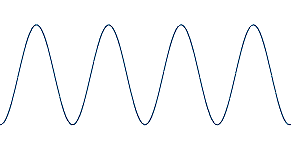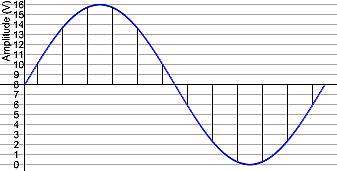
| Microphones convert sound waves into electrical signals. A sound generates changes in air pressure which cause a diaphragm in the microphone to vibrate. Various methods are used to convert the movement of the diaphragm into a continuously varying electrical current. The rising and falling voltage level mimics (is analogous to) the sound wave. | 
|
|
Before it can be processed by a computer, the current must be digitized. A device called an analog to digital (a to d) converter will sample the signal at fixed intervals.
Zooming in, we see the sample values (on the vertical axis) at regular time intervals (the horizontal axis). Note that the numbers are not exact, but are rounded to the nearest whole number. For example, the second sample is between 13 and 14 volts, but it is rounded to 14. The sampling illustrated above produces a list of twelve 5-bit binary numbers, as shown below. |

|
| Sample | 1 | 2 | 3 | 4 | 5 | 6 | 7 | 8 | 9 | 10 | 11 | 12 |
| Volts | 10 | 14 | 16 | 16 | 14 | 10 | 6 | 2 | 0 | 0 | 2 | 6 |
| Binary | 01010 | 01110 | 10000 | 10000 | 01110 | 01010 | 00110 | 00010 | 00000 | 00000 | 00010 | 00110 |
|
We could increase the accuracy or fidelity in two ways. Increasing the sampling rate would improve recording fidelity since the samples would follow the signal more closely.
Increasing sample precision or depth, the number of bits in each sample, would also increase fidelity by reducing rounding errors. Of course, we have a tradeoff between file size and fidelity. Increasing either the sampling rate or precision increases file size. |

|
Audio files can get quite large. On an audio CD, the sampling rate is 44,000 samples per second and each sample is a 16-bit number. If you double that for a stereo recording, it works out to 6,265,728,000 bits on a 74-minute CD.
To hear recorded sound, the stream of samples is converted back to an electrical signal using a digital to analog (D to A) converter. A D to A converter would read the stream of values representing the sound, and generate the corresponding electrical signal by "connecting the dots."
The signal coming from the D to A converter is fed to a speaker which vibrates in response to its variation, moving air and producing audible sound.